The MSI GS66 is a thinner gaming laptop with some powerful hardware inside, so just how hot does it get? Let’s find out and see what improvements can be made to thermals and performance.
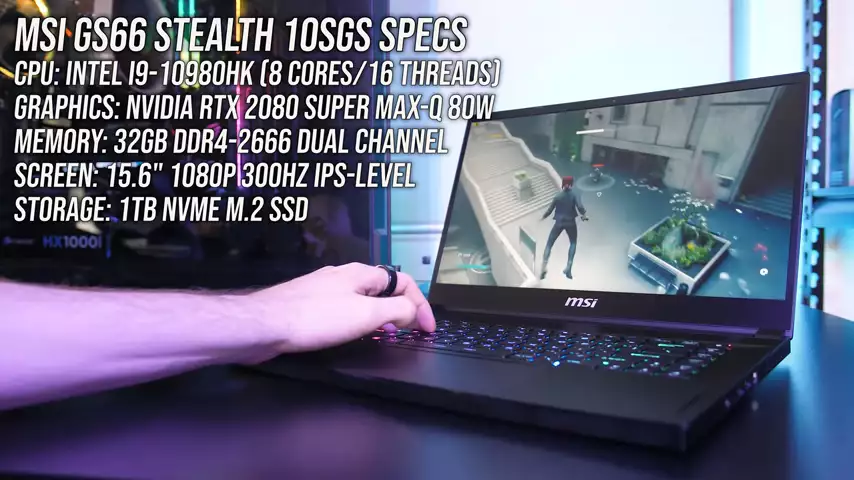 The GS66 is available in different configurations, my model has an 8 core overclockable Intel i9-10980HK CPU, Nvidia RTX 2080 Super Max-Q graphics, and 32gb of memory running in dual channel, so expect different results with different specs.
The GS66 is available in different configurations, my model has an 8 core overclockable Intel i9-10980HK CPU, Nvidia RTX 2080 Super Max-Q graphics, and 32gb of memory running in dual channel, so expect different results with different specs.
Air comes in from the bottom, in through the vents above the keyboard, and is exhausted out of the left and right sides towards the back, and rear left and right corners. Inside there are 7 heatpipes in total, 2 shared between the CPU and GPU with 3 fans.
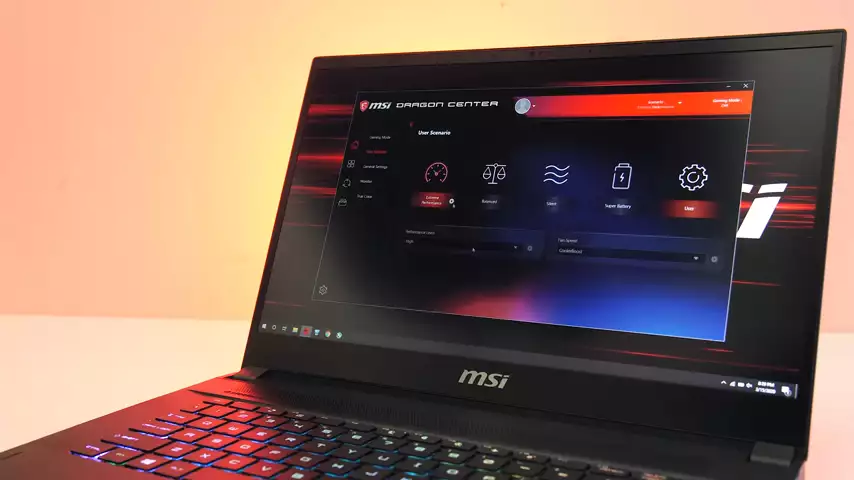 The MSI Dragon Center software lets you select different performance modes, which from lowest to highest are silent, balanced and extreme performance. Only extreme performance lets you enable coolerboost, which sets the fan to maximum speed. It also applies a GPU overclock, which can further be adjusted here too, but I’ve tested with the default overclock. The fans can be customized a bit in the user mode.
The MSI Dragon Center software lets you select different performance modes, which from lowest to highest are silent, balanced and extreme performance. Only extreme performance lets you enable coolerboost, which sets the fan to maximum speed. It also applies a GPU overclock, which can further be adjusted here too, but I’ve tested with the default overclock. The fans can be customized a bit in the user mode.
I also need to note that undervolting was disabled in my unit, the option was greyed out in the latest version of XTU and Throttlestop didn’t work, likely as a mitigation to the plundervolt vulnerability. You can also quickly set the fan speed to maximum by pressing the function and F8 keys.
Thermals were tested with a 21 degree Celsius ambient room temperature. 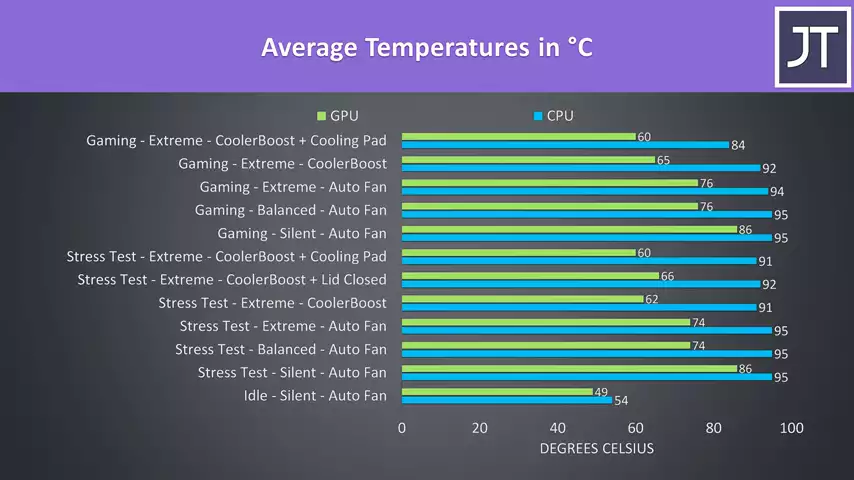 Idle results down the bottom were on the warmer side but no real issue with that. Worst case stress tests were done with the Aida64 CPU stress test with CPU only checked and the Heaven benchmark at max settings at the same time, and gaming was tested with Watch Dogs 2 as I find it to use a good combination of processor and graphics.
Idle results down the bottom were on the warmer side but no real issue with that. Worst case stress tests were done with the Aida64 CPU stress test with CPU only checked and the Heaven benchmark at max settings at the same time, and gaming was tested with Watch Dogs 2 as I find it to use a good combination of processor and graphics.
I’ll start off by noting that the CPU was thermal throttling at 95 degrees Celsius, which we can see happening in just under half of these worst case tests. The GPU was thermal throttling when it was at 86 degrees, but this only happened with silent mode enabled, which as you’ll hear soon runs the fans very quiet, so that’s expected.
Balanced and extreme modes are the same from a temperature perspective, then enabling coolerboost mode offers some improvement and removes thermal throttling. I also tested the stress test with the lid closed, and the temperatures didn’t rise up too much higher, so even under heavy load that should be ok. The cooling pad only helped improve temperatures a little in the stress tests, but offered a larger improvement while gaming.
These are the average clock speeds while running the same tests. 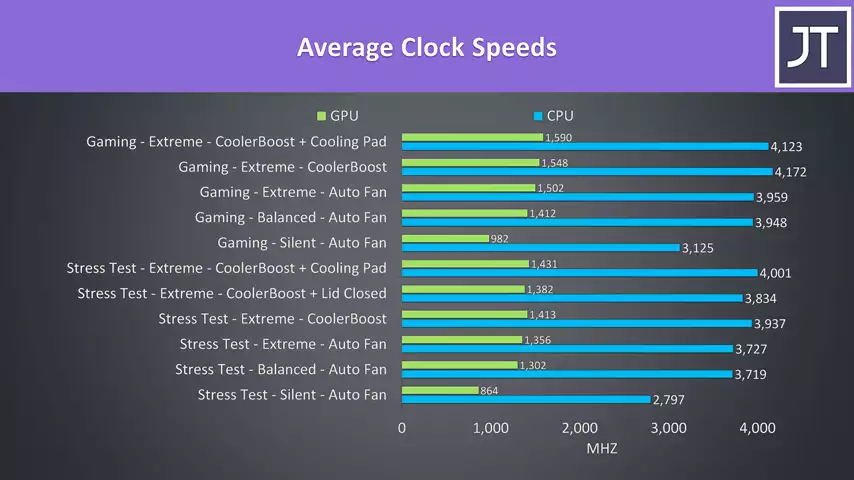 Keep in mind this is an 8 core CPU, so the fact that we can surpass 4GHz and approach 4.2GHz is quite impressive when you consider I can’t undervolt.
Keep in mind this is an 8 core CPU, so the fact that we can surpass 4GHz and approach 4.2GHz is quite impressive when you consider I can’t undervolt.
The speeds in silent mode aren’t as low as other laptops I’ve tested, so gaming with quieter fans may be possible, we’ll check a game shortly. Balanced and extreme modes performed basically the same for the CPU, however the GPU does see a clock speed bump due to the overclock extreme mode applies. Performance improves with coolerboost enabled as thermal throttling was the limit and this removed it, and closing the lid didn’t have too much of a negative effect.
These are the average power levels from the same tests. 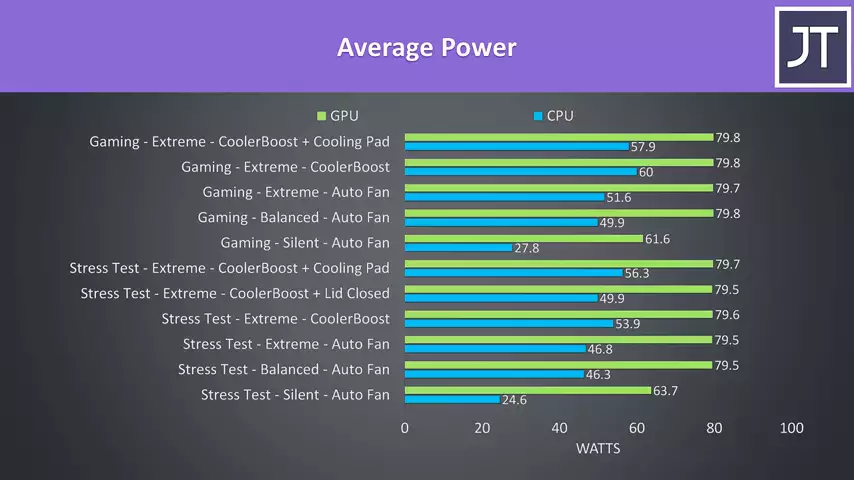 Despite Intel XTU reporting the PL1 as 65 watts at all setting levels, I found the power limit would dynamically change over time based on the temperatures. Outside of silent mode, the 2080 Super Max-Q had no issues running at its 80 watt limit, however considering the GPU was fairly cool outside of silent mode as we saw earlier, perhaps a 90 watt option for Extreme mode could have been possible.
Despite Intel XTU reporting the PL1 as 65 watts at all setting levels, I found the power limit would dynamically change over time based on the temperatures. Outside of silent mode, the 2080 Super Max-Q had no issues running at its 80 watt limit, however considering the GPU was fairly cool outside of silent mode as we saw earlier, perhaps a 90 watt option for Extreme mode could have been possible.
With cooler boost enabled and the thermal throttling removed, power limit throttling was the next limitation, however I couldn’t adjust this with XTU, as mentioned it seemed to be dynamically controlling itself regardless of what was set.
I didn’t even bother attempting manual overclocking, as MSI already set the all core turbo boost speed of the i9-10980HK to 5.3GHz. Given best case in my tests we reached 4.2GHz on all cores, which is still a good result, there’s no point modifying this.
I think this is a good move for the most part, it’s just one less restriction on the CPU. If thermals and power limit allow it will just clock higher if possible. Let’s actually see how games perform with these different settings.
I’ve tested Shadow of the Tomb Raider with the highest setting preset using the game’s benchmark tool. 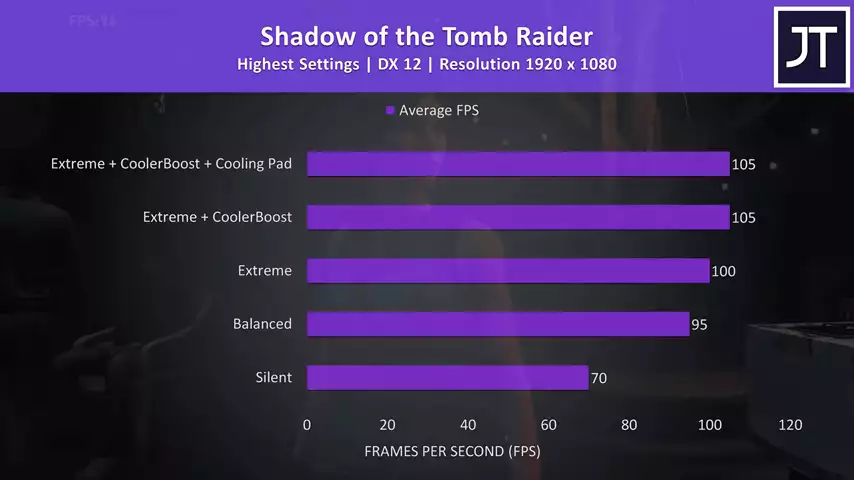 With silent mode down the bottom the results are still pretty decent, like we saw earlier there was still alright CPU performance there, so gaming with the fans quieter is possible, though I will note after a while the WASD keys started getting quite warm. Extreme mode sees a 5 FPS boost over balanced as it applies a GPU overclock, then the higher fan speed raises things up further, however I didn’t find the cooling pad to help further in this specific game.
With silent mode down the bottom the results are still pretty decent, like we saw earlier there was still alright CPU performance there, so gaming with the fans quieter is possible, though I will note after a while the WASD keys started getting quite warm. Extreme mode sees a 5 FPS boost over balanced as it applies a GPU overclock, then the higher fan speed raises things up further, however I didn’t find the cooling pad to help further in this specific game.
Now let’s take a look at a CPU only workload with the GPU idle. 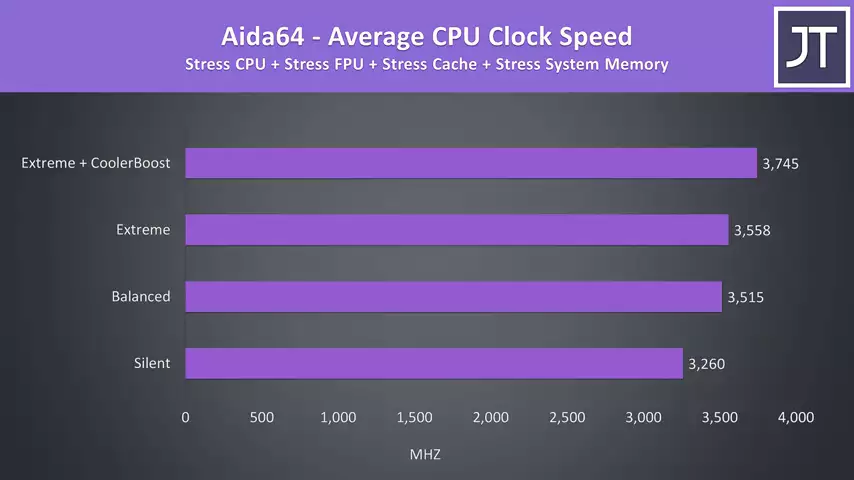 Here are the clock speeds while running the Aida64 CPU stress test with all the default options checked.
Here are the clock speeds while running the Aida64 CPU stress test with all the default options checked. 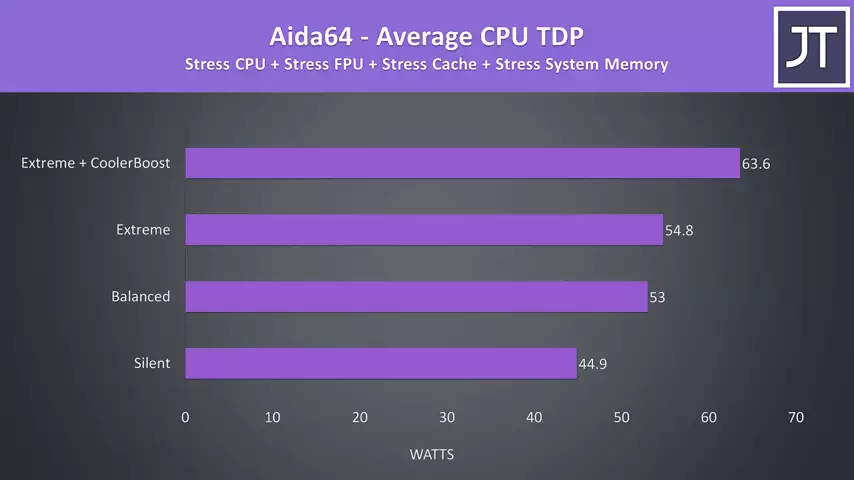
Higher speeds are possible as higher power limits are being hit as we step up to higher performance modes.
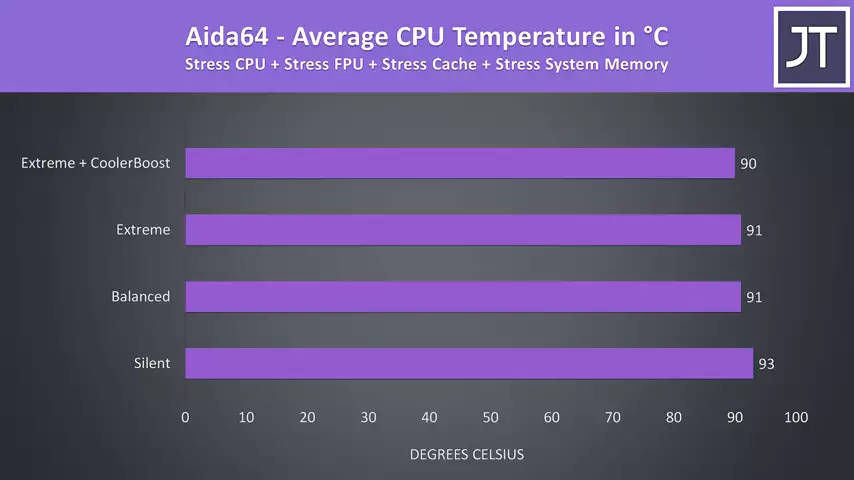 More power equals more heat, however with the GS66 the fans get louder as we increase through these modes, so we actually see a small reduction as we boost performance.
More power equals more heat, however with the GS66 the fans get louder as we increase through these modes, so we actually see a small reduction as we boost performance.
This is why workloads in silent mode perform better than many other laptops,, so as long as you’re fine with higher temperatures you can certainly run with lower fan speeds.
Here are some Cinebench results to give you an idea of CPU only performance when the GPU is idle. 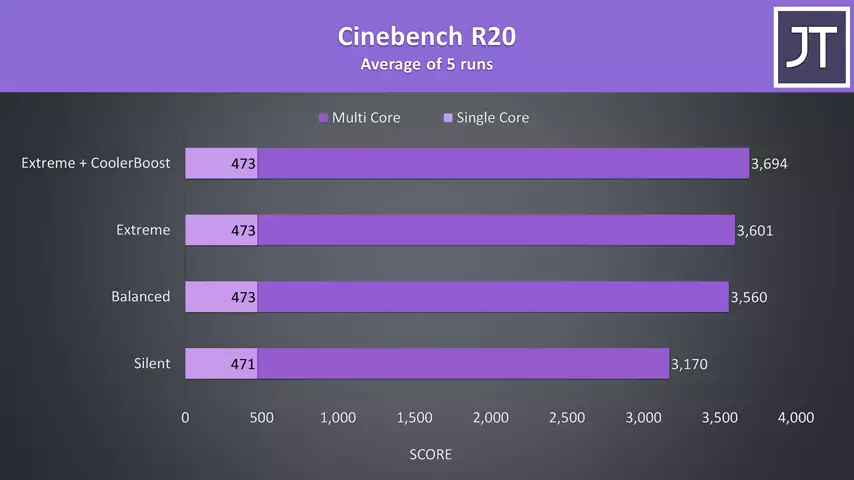 Silent mode wasn’t too far behind the others, and balanced and extreme were basically the same, matching what we’ve seen previously. Enabling coolerboost only improved the multicore score by 2.6%
Silent mode wasn’t too far behind the others, and balanced and extreme were basically the same, matching what we’ve seen previously. Enabling coolerboost only improved the multicore score by 2.6%
Here’s how the GS66 stacks up against other 8 core laptops I’ve tested in the past. 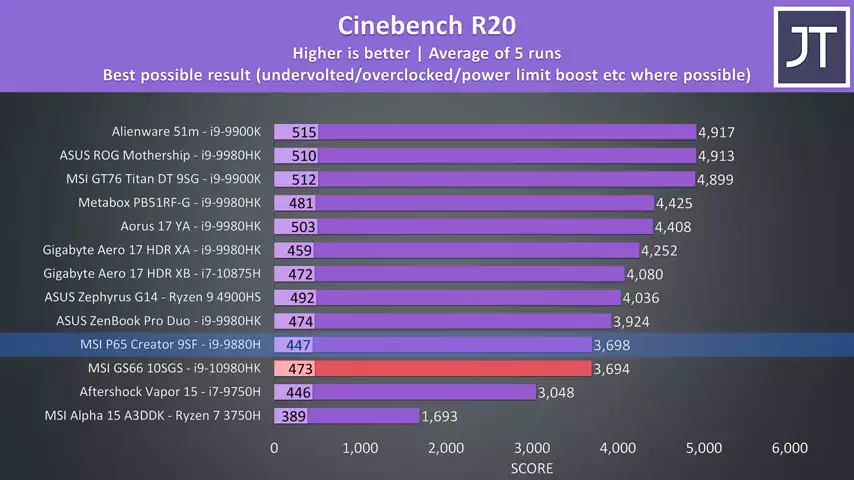 It’s close to the 9th gen 9880H for multicore in a similar sized chassis, although the higher single core speed of the 10th gen i9 gives it a better single core score. The Ryzen 9 4900HS is outperforming the 10980HK in the GS66 despite being in a thinner and smaller 14” machine, otherwise the reason the 10th gen i9 is behind so many of the other i9s comes down to power and thermal limits of the specific machine it’s placed in.
It’s close to the 9th gen 9880H for multicore in a similar sized chassis, although the higher single core speed of the 10th gen i9 gives it a better single core score. The Ryzen 9 4900HS is outperforming the 10980HK in the GS66 despite being in a thinner and smaller 14” machine, otherwise the reason the 10th gen i9 is behind so many of the other i9s comes down to power and thermal limits of the specific machine it’s placed in.
As for the external temperatures where you’ll actually be putting your hands, at idle it was in the mid 30s, so a little warmer than many other laptops I’ve tested but no issue. 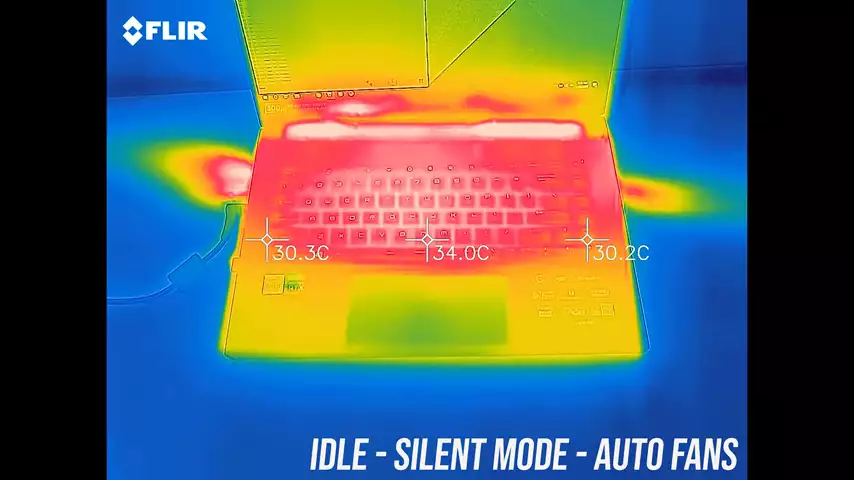 With the stress tests running in silent mode the center was actually hot to the touch.
With the stress tests running in silent mode the center was actually hot to the touch.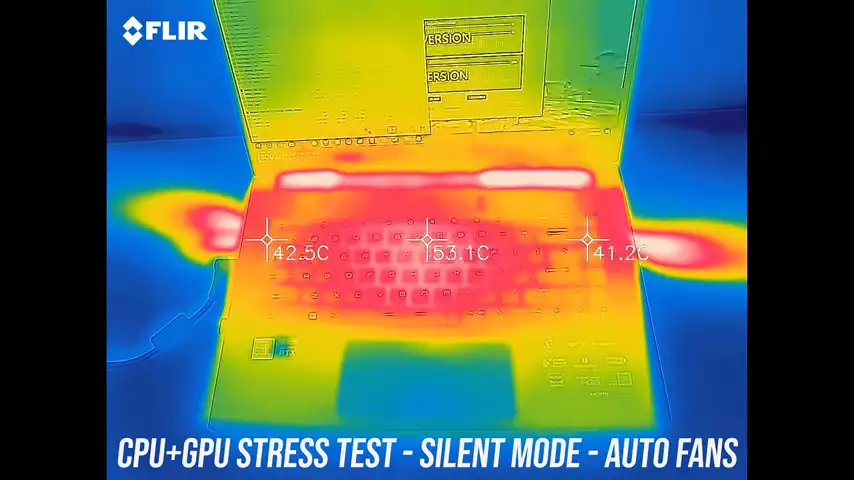 In balanced mode it’s performing better and also cooler in the center now due to higher fan speed.
In balanced mode it’s performing better and also cooler in the center now due to higher fan speed.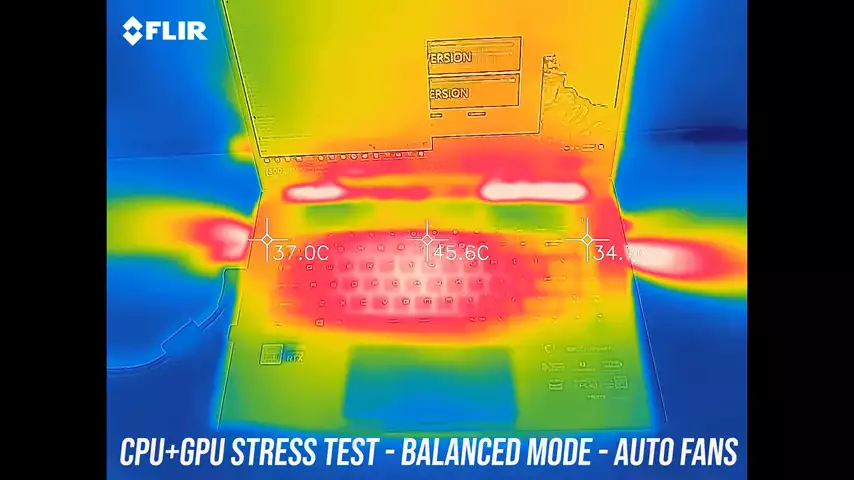
Extreme mode seemed the same as balanced, which makes sense given it performed equivalently.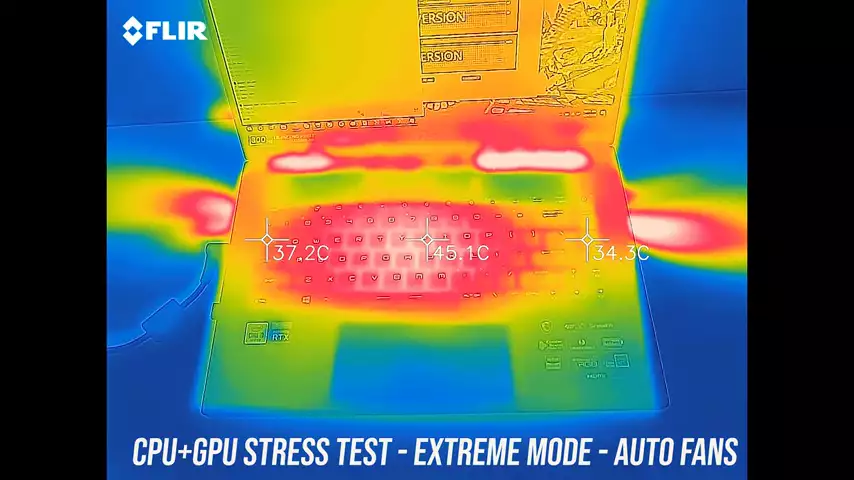 With cooler boost mode the wrist rests actually felt cool now, they were warm before but not hot, and the middle was now only warm
With cooler boost mode the wrist rests actually felt cool now, they were warm before but not hot, and the middle was now only warm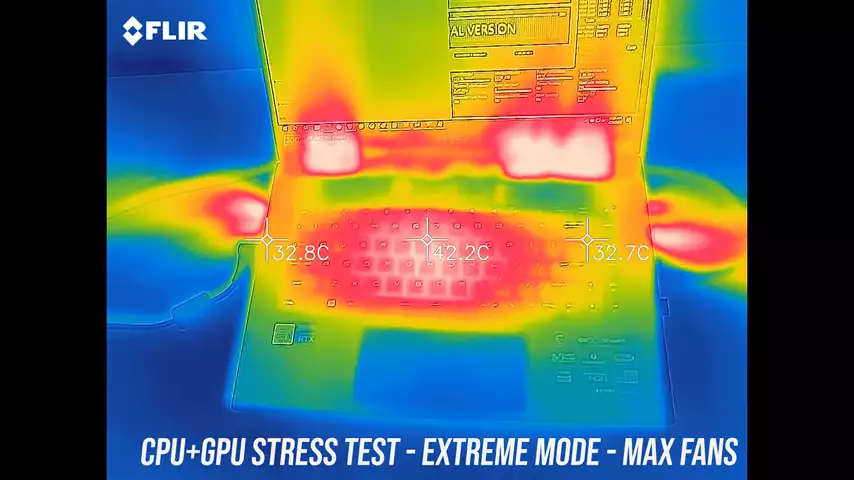 however the fan is quite loud to achieve this.
however the fan is quite loud to achieve this.
The fans were only just audible in silent mode, but they would spin up ever so slightly from time to time. With the stress tests in the same silent mode it’s still on the quieter side. Both balanced and extreme modes were about the same, which explains why the performance in these modes was basically the same, and then coolerboost is about 10 decibels louder and is quite loud. Although max fan speed is loud, I see this as an advantage. Rather than being locked to a lower fan speed and being forced to run hotter, the user at least has the choice, and there is some basic fan control available so it should be possible to find a mix of noise and thermals that works for you.
Considering that the GS66 is just under 2cm thick and is paired with the top end i9-10980HK and RTX 2080 Super max-Q graphics in the configuration we’re looking at here, I’m pretty impressed with the results, especially when you remember that undervolting is locked. It’s a shame about the lack of undervolting, but so far that’s been the case for 5 10th gen laptops so far. Not only were we hitting good clock speeds, the exterior of the machine in extreme mode was fairly cool, and even more so with coolerboost enabled, however as we heard it does get quite loud at maximum. This is important to note, most laptops that have all metal bodies conduct the heat much easier than plastic and usually feel warmer, but that was less noticeable here, especially with higher fan speeds.
Outside of silent mode, the GPU was running cooler than I expected, I guess because it’s capped to 80 watts. I’m guessing MSI didn’t go with 90 watts even if the GPU would be fine, as it would contribute more heat into the shared heatpipes, and as we saw CPU thermals were the key limitation in most tests.
Despite thermal throttling being hit, simply enabling coolerboost mode was enough to remove it without any further changes, even in these worst case stress tests, though a cooling pad was able to help further. For gaming, the task the GS66 is advertised for, honestly most people probably won’t even notice a difference between the i9 here or the i7 model which will be cheaper, and presumably be easier to cool. These differences in performance shown aren’t hard and fast rules, there are different factors which will vary results, primarily the temperature of the room you’re running in, application of thermal paste, and even the specific hardware which comes down to the silicon lottery.
It may be possible to further improve temperatures by swapping the thermal paste, however as this is a review unit that I have to send back I’m not able to change the paste, otherwise the next reviewer will unknowingly report different results due to what I’ve done. Let me know what you thought about the thermals from the MSI GS66 gaming laptop down in the comments.
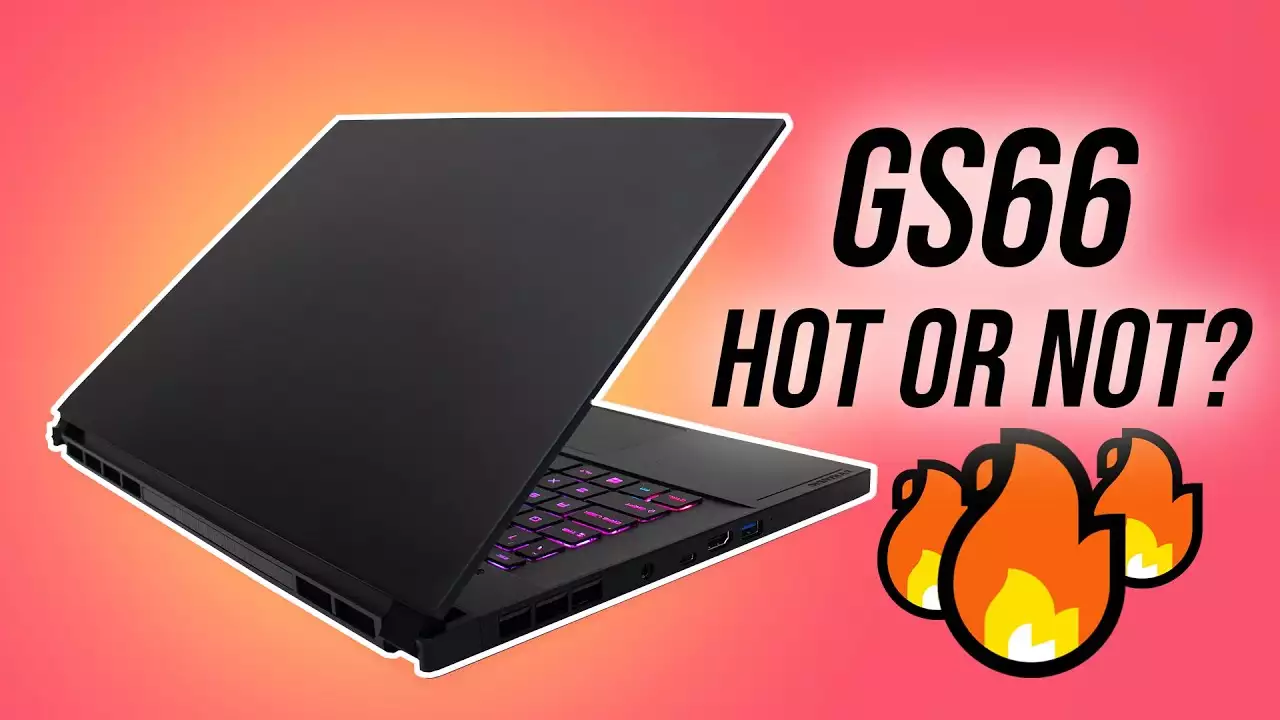

No comments yet